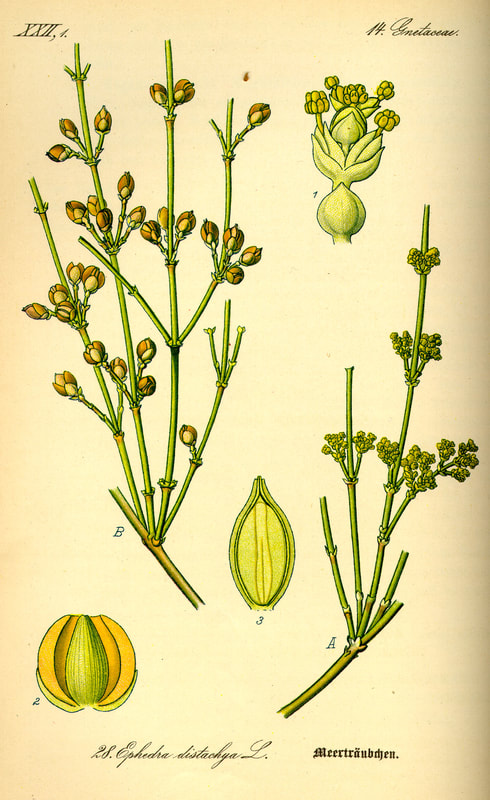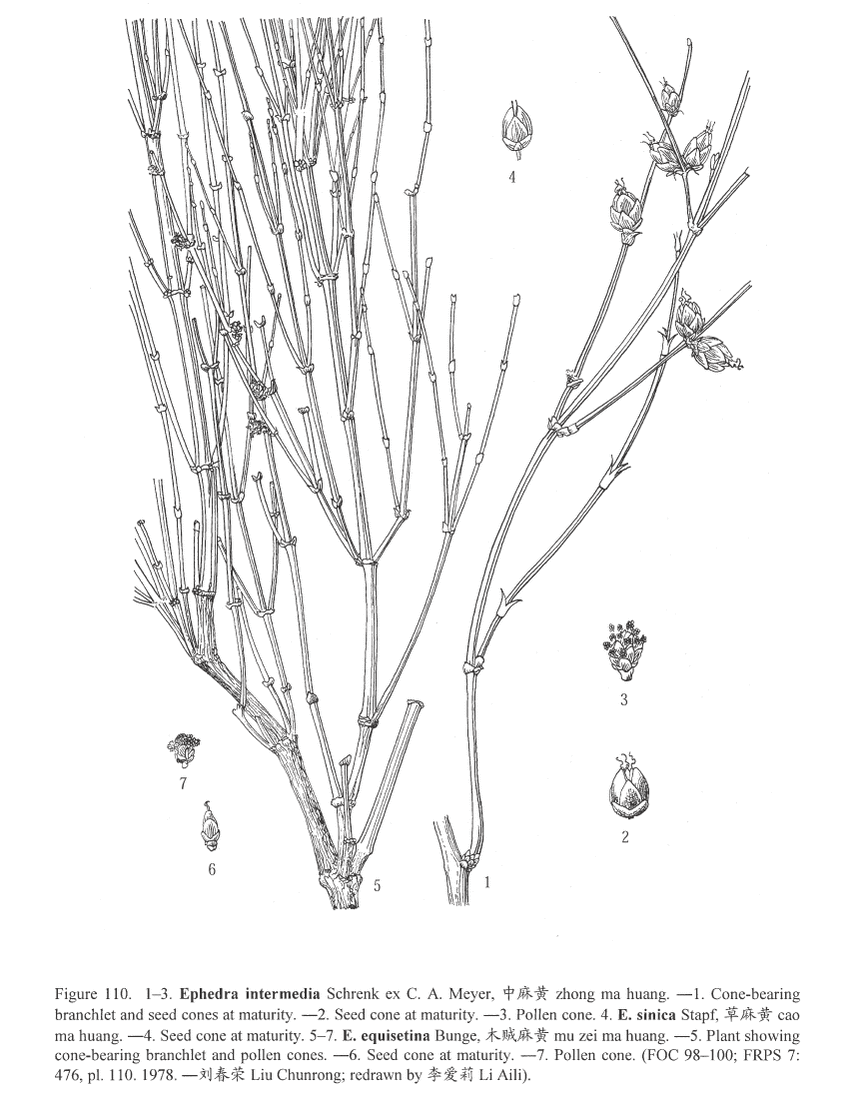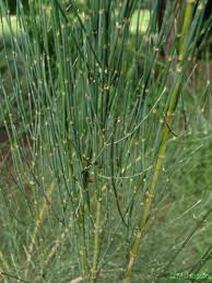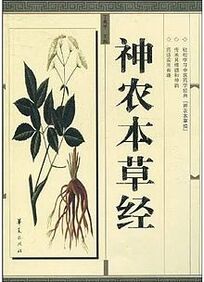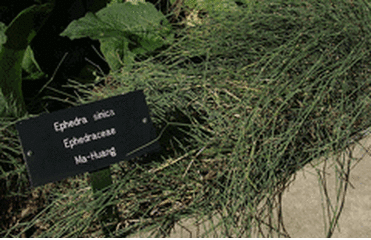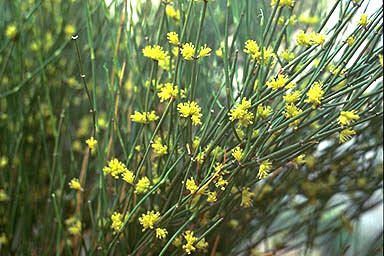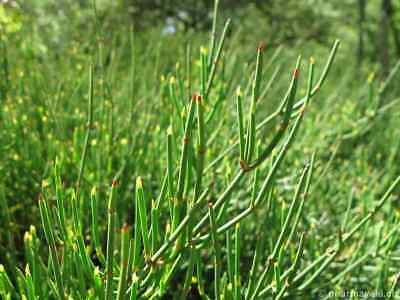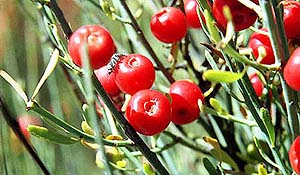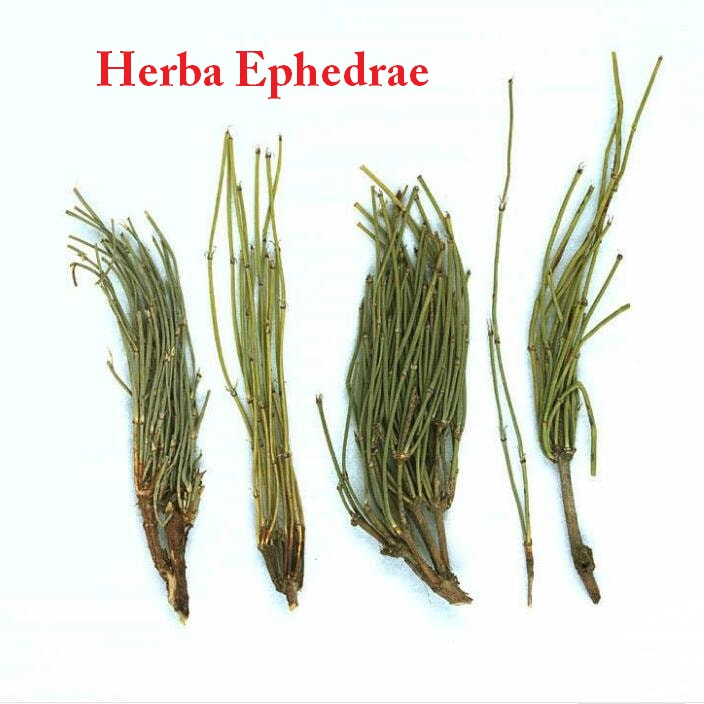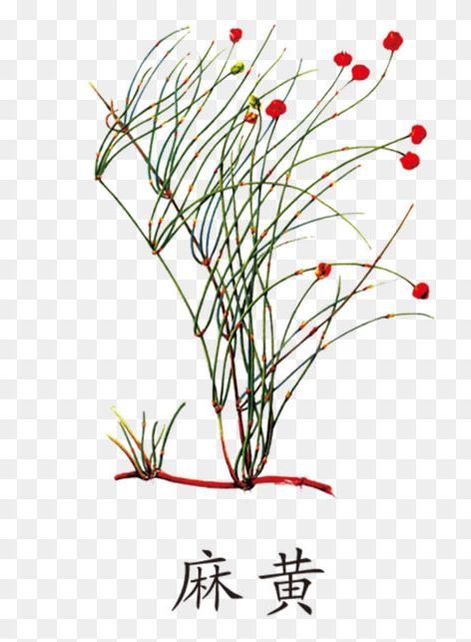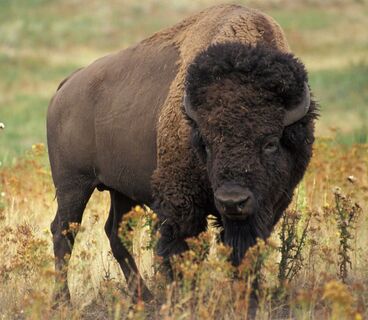E. sinica, 'Ma Huang,' TCM; It's Use, Lore and Cultivation Information:
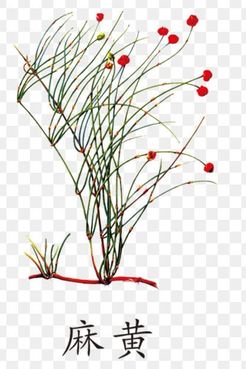
A Traditional Chinese Medicinal herbal plant in use for well over 2,000 years. Native to all of Mongolia, as well as neighboring regions of Russia and China. Grows in the Gobi Desert.
For about 2,000 years, the Qawrighul people of western China buried their dead with bundles of E. sinica twigs tied to them.
The medicinal herb Ma Huang is made of the dried, young branchlets of the ephedra plant. Harvested in autumn, the stems are dried in the sun throughout the year for production. The herb should be stored away from light.
NOTE: Only the stems contain alkaloids. The flower pods, the seeds, and the roots contain virtually no alkaloids whatsoever. Crushing seeds for ephedrine is a total waste of seeds, time and money, as no alkaloids are present in the plant's dark seeds.
Ephedra sinica stems contain a number of alkaloids including ephedrine, pseudoephedrine, norephedrine, norpseudoephedrine (cathine), methylephedrine and methylpseudoephedrine.
Ephedra sinica is a perennial horsetail plant which produces leafless, segmented round canes similar to many succulents. It doesn't have "normal" leaves, instead it produces rigid, blue-green branches to form an ever-widening mat. The fruits are red, and contain small oblong, black seeds that develop in fall.
Ephedra sinica is an evergreen shrub, growing to about 18 in. It is in leaf all year, in flower from May to June, and the seeds ripen from August to September. The species is dioecious (individual flowers are either male or female, but only one gender is to be found on any one plant; so both male and female plants must be grown if seed is desired). The plant is not self-fertile so both male and female plants must be grown to fertilize the flowers. Ephedra is reproduced from seed or by root division.
I also recommend reading an excellent narrative by my old Santa Cruz friend Dr. Christopher Hobbs. at this link: Christopher
Christopher is a master herbalist with extensive botanical experience in traditional North American herbs as well as TCM herbs. (I first met him over 30 years ago in the Santa Cruz mountains when he would shop in my natural foods store and I would join him on herb walks once in awhile. Also I would spend time with TCM Doctor Michael Tierra and master acupuncturist Holly Eagle.)
Ephedra sinica Seed Germination Instructions:
Plant Care:
Soils: Light (sandy) and medium (loamy) soils; prefers well-drained soil.
pH: High versatility. Acid, neutral and/or alkaline soils.
Sun: It cannot grow in the shade; full sun needed.
Water: It prefers dry or just slightly moist soil and can tolerate drought.
Natural Locations: Desert. Found in sandy places, high plains, mountain slopes; usually at 2,000-5,000 ft. altitude.
Frost: Can handle hard frost, temps to 10F or so.
Plant Description:
E. sinica is a perennial evergreen that reaches heights of approximately half a meter. The scarce leaves grow in slender cylindrical, yellow-green branches. It flowers in August with colorful red-fleshy cones that look similar to berries.
Subshrubs small, to 40 cm, sparsely branched; woody stems short or prostrate; branchlets straight or curved, sometimes slightly involute, internodes (2.5-)3-4(-5.5) cm × ca. 2 mm, shallowly furrowed. Leaves opposite, connate for 1/3-2/3 their length, free part subulate to narrowly triangular, to 5 mm, apex sharply pointed. Pollen cones sessile or pedunculate, solitary or in clusters at nodes, rarely terminal; bracts in 4 pairs, margin very narrow, membranous, apex obtuse or subacute; anthers 7 or 8, sessile or shortly stipitate. Seed cones terminal or axillary, solitary, oblong-ovoid or subglobose, ca. 8 × 6-7 mm at maturity; bracts in four pairs, connate for 1/2-3/4 their length, red and fleshy at maturity; integument tube 1-2 mm, straight or slightly curved. Seeds usually two, black-red or grayish brown, concealed by or equaling bracts. Pollination May-Jun, seed maturity Aug-Sep.
Traditional Chinese Medicinal Uses:
This species has medicinal properties. Ma Huang is a strongly stimulating, acrid-tasting herb that is commonly used in Traditional Chinese Medicine (TCM), and is one of the 50 basic fundamental herbs in TCM. Ma Huang was first recorded in the Shen-nung Pen-ts’ao Ching (Divine Farmer’s Materia Medica), the earliest Chinese pharmacopoeia written before 200 B.C. Most members of this genus contain various medicinally active alkaloids (notably ephedrine) that are widely used in preparations for the treatment of catarrh and asthma. Ephedrine has effects similar to adrenaline, caffeine or amphetamines in the body. It acts promptly to reduce swellings of the mucous membranes and has anti-inflammatory, anti-arthritic and antispasmodic properties.
The whole plant can be used at much lower concentrations than the isolated constituents; unlike using the isolated ephedrine, using the whole plant rarely gives rise to bad side-effects. The stems are a pungent, bitter, warm herb that dilates the bronchial vessels while stimulating the heart and central nervous system. The stems are also antidote, diaphoretic, diuretic, pectoral, vasoconstrictor and vasodilator. They are used internally in the treatment of asthma, hay fever and allergic complaints. The plant also has antiviral effects, particularly against influenza. Ephedra is often combined with a number of other herbs in TCM and used in treating a wide range of complaints by certified Acupuncturists and Traditional Chinese Medical Doctors.
Ephedra is probably the strongest stimulant and diaphoretic herb in TCM. It has an action much like pure adrenaline. It can be used as a substitute for coffee, but also has side effects (reduced somewhat by the addition of licorice to it). It may overstimulate the adrenals and burn out the nerves by its rajasic quality.
Ephedra is a powerful bronchodilator and is the source of ephedrine, one of the main medicines for asthmatic attacks. It is one of the most powerful Kapha reducing herbs, relieving cold, mucus, cough and edems, and promoting wakefulness and activity. It is used in many stimulant herbal blends and strongly stimulates the nerves. It relieves point pain, promotes peripheral circulation, and cleanses the lymphatics. It may be used with other milder diaphoretics like cinnamon and ginger.
Tannins present in ephedra possess astringent effects and have historically been used in topical preparations to reduce oozing and weeping of skin lesions.
Contraindications:
Toxicity:
Potentially Harmful Ephedrine drug Interactions:
Alkaloid Details:
Ephedra contains the alkaloids ephedrine, pseudoephedrine (isoephedrine), norpseudoephedrine (cathine), norephedrine, methylephedrine, and methylpseudoephedrine, as well as tannins and other constituents, including quinoline and 6-hydroxykynurenic acid. The stem contains approximately 0.5-2.5% alkaloids, with ephedrine accounting for 30-90% of the total alkaloid content. The variation in content depends upon the part of the plant used. For example, the newer, softer stems contain up to 2.5% active alkaloids, while the older woody stems are much lower in alkaloids, whereas the fruits, seeds and roots have practically no measurable alkaloids at all.
Ephedrine and pseudoephedrine are found only in the stems of the plant. These alkaloids are structurally related to amphetamines and have similar effects. They increase the availability and action of the endogenous neurotransmitters norepinephrine and epinephrine and stimulate catecholamine receptors in the brain, heart, and blood vessels both directly and indirectly. Both ephedrine and pseudoephedrine elicit central nervous system stimulation, bronchodilation, hypertension, and chronotropic/inotropic effects.
Norpseudoephedrine is also called cathine, because it is a major alkaloid of the plant Catha edulis, commonly called khat, a plant that is widely used as a stimulant in some countries of East Africa and the Arab Peninsula.
Ephedrine is easily absorbed after oral ingestion, with a reported half-life of 3-6 hours. Following oral administration, 88% is excreted in the urine within 24 hours, and 97% is excreted within 48 hours. Ephedrine and pseudoephedrine are excreted more rapidly with urinary acidifiers (such as: ammonium chloride) and more slowly with urinary alkalinizers (such as: disodium bicarbonate).
© Copyright 2012-2024, Shaman Don, White Buffalo Trading, All rights reserved.
For about 2,000 years, the Qawrighul people of western China buried their dead with bundles of E. sinica twigs tied to them.
The medicinal herb Ma Huang is made of the dried, young branchlets of the ephedra plant. Harvested in autumn, the stems are dried in the sun throughout the year for production. The herb should be stored away from light.
NOTE: Only the stems contain alkaloids. The flower pods, the seeds, and the roots contain virtually no alkaloids whatsoever. Crushing seeds for ephedrine is a total waste of seeds, time and money, as no alkaloids are present in the plant's dark seeds.
Ephedra sinica stems contain a number of alkaloids including ephedrine, pseudoephedrine, norephedrine, norpseudoephedrine (cathine), methylephedrine and methylpseudoephedrine.
Ephedra sinica is a perennial horsetail plant which produces leafless, segmented round canes similar to many succulents. It doesn't have "normal" leaves, instead it produces rigid, blue-green branches to form an ever-widening mat. The fruits are red, and contain small oblong, black seeds that develop in fall.
Ephedra sinica is an evergreen shrub, growing to about 18 in. It is in leaf all year, in flower from May to June, and the seeds ripen from August to September. The species is dioecious (individual flowers are either male or female, but only one gender is to be found on any one plant; so both male and female plants must be grown if seed is desired). The plant is not self-fertile so both male and female plants must be grown to fertilize the flowers. Ephedra is reproduced from seed or by root division.
I also recommend reading an excellent narrative by my old Santa Cruz friend Dr. Christopher Hobbs. at this link: Christopher
Christopher is a master herbalist with extensive botanical experience in traditional North American herbs as well as TCM herbs. (I first met him over 30 years ago in the Santa Cruz mountains when he would shop in my natural foods store and I would join him on herb walks once in awhile. Also I would spend time with TCM Doctor Michael Tierra and master acupuncturist Holly Eagle.)
Ephedra sinica Seed Germination Instructions:
- Sow in Spring.
- Sprinkle seeds on top of an airy, loose soil mix that contains 50% sand and 50% cactus mix. Or, one inch of sand on the top with cactus mix below that. Barely cover seeds.
- Water once a day.
- Use a grow light and commercial heating pad for optimal results.
- Keep the environment warm (80 degrees F.).
- Place in a bright area, with full light. (I had one customer sprout in total darkness, so may not be crucial)
- Germination usually in 1-3 weeks, with stragglers up to two years later. Seeds are dormant. Pull seeds after a month, dry out, and try again.
- Keep stems dry on young sprouts. Avoid rot and damping off.
- At four inches tall transplant into gallon pots for one year. Provide a mulch of coarse sand around the crown.
- Do NOT use peat moss or peat cubes as they will rot all desert seeds! Totally amateur mistake.
Plant Care:
Soils: Light (sandy) and medium (loamy) soils; prefers well-drained soil.
pH: High versatility. Acid, neutral and/or alkaline soils.
Sun: It cannot grow in the shade; full sun needed.
Water: It prefers dry or just slightly moist soil and can tolerate drought.
Natural Locations: Desert. Found in sandy places, high plains, mountain slopes; usually at 2,000-5,000 ft. altitude.
Frost: Can handle hard frost, temps to 10F or so.
- Treat similar to a cactus, dry and warm. Lightly water once a week. Well drained, sandy soil is best. Deep roots find water.
Plant Description:
E. sinica is a perennial evergreen that reaches heights of approximately half a meter. The scarce leaves grow in slender cylindrical, yellow-green branches. It flowers in August with colorful red-fleshy cones that look similar to berries.
Subshrubs small, to 40 cm, sparsely branched; woody stems short or prostrate; branchlets straight or curved, sometimes slightly involute, internodes (2.5-)3-4(-5.5) cm × ca. 2 mm, shallowly furrowed. Leaves opposite, connate for 1/3-2/3 their length, free part subulate to narrowly triangular, to 5 mm, apex sharply pointed. Pollen cones sessile or pedunculate, solitary or in clusters at nodes, rarely terminal; bracts in 4 pairs, margin very narrow, membranous, apex obtuse or subacute; anthers 7 or 8, sessile or shortly stipitate. Seed cones terminal or axillary, solitary, oblong-ovoid or subglobose, ca. 8 × 6-7 mm at maturity; bracts in four pairs, connate for 1/2-3/4 their length, red and fleshy at maturity; integument tube 1-2 mm, straight or slightly curved. Seeds usually two, black-red or grayish brown, concealed by or equaling bracts. Pollination May-Jun, seed maturity Aug-Sep.
Traditional Chinese Medicinal Uses:
This species has medicinal properties. Ma Huang is a strongly stimulating, acrid-tasting herb that is commonly used in Traditional Chinese Medicine (TCM), and is one of the 50 basic fundamental herbs in TCM. Ma Huang was first recorded in the Shen-nung Pen-ts’ao Ching (Divine Farmer’s Materia Medica), the earliest Chinese pharmacopoeia written before 200 B.C. Most members of this genus contain various medicinally active alkaloids (notably ephedrine) that are widely used in preparations for the treatment of catarrh and asthma. Ephedrine has effects similar to adrenaline, caffeine or amphetamines in the body. It acts promptly to reduce swellings of the mucous membranes and has anti-inflammatory, anti-arthritic and antispasmodic properties.
The whole plant can be used at much lower concentrations than the isolated constituents; unlike using the isolated ephedrine, using the whole plant rarely gives rise to bad side-effects. The stems are a pungent, bitter, warm herb that dilates the bronchial vessels while stimulating the heart and central nervous system. The stems are also antidote, diaphoretic, diuretic, pectoral, vasoconstrictor and vasodilator. They are used internally in the treatment of asthma, hay fever and allergic complaints. The plant also has antiviral effects, particularly against influenza. Ephedra is often combined with a number of other herbs in TCM and used in treating a wide range of complaints by certified Acupuncturists and Traditional Chinese Medical Doctors.
Ephedra is probably the strongest stimulant and diaphoretic herb in TCM. It has an action much like pure adrenaline. It can be used as a substitute for coffee, but also has side effects (reduced somewhat by the addition of licorice to it). It may overstimulate the adrenals and burn out the nerves by its rajasic quality.
Ephedra is a powerful bronchodilator and is the source of ephedrine, one of the main medicines for asthmatic attacks. It is one of the most powerful Kapha reducing herbs, relieving cold, mucus, cough and edems, and promoting wakefulness and activity. It is used in many stimulant herbal blends and strongly stimulates the nerves. It relieves point pain, promotes peripheral circulation, and cleanses the lymphatics. It may be used with other milder diaphoretics like cinnamon and ginger.
Tannins present in ephedra possess astringent effects and have historically been used in topical preparations to reduce oozing and weeping of skin lesions.
Contraindications:
- Individuals with high blood pressure and heart troubles should avoid E. sinica.
- Use with medical supervision in the presence of cardiovascular disorders, thyroid disease, diabetes or BPH.
- Ephedra should not be used by people with low body weight issues.
Toxicity:
- Stimulation of the autonomic nervous system producing symptoms such as tachycardia and extreme hypertension.
- May cause heart spasms.
Potentially Harmful Ephedrine drug Interactions:
- With cardiac glycosides, Ephedra use can produce cardiac arrhythmia.
- Mixing with any other sympathomimetics, alkaloid derivatives (ergotamine), Oxytocin, or any MAOI can cause extreme and/or fatal hypertension.
- Never mix with wild Syrian Rue, Peganum harmala, a natural MAOI.
Alkaloid Details:
Ephedra contains the alkaloids ephedrine, pseudoephedrine (isoephedrine), norpseudoephedrine (cathine), norephedrine, methylephedrine, and methylpseudoephedrine, as well as tannins and other constituents, including quinoline and 6-hydroxykynurenic acid. The stem contains approximately 0.5-2.5% alkaloids, with ephedrine accounting for 30-90% of the total alkaloid content. The variation in content depends upon the part of the plant used. For example, the newer, softer stems contain up to 2.5% active alkaloids, while the older woody stems are much lower in alkaloids, whereas the fruits, seeds and roots have practically no measurable alkaloids at all.
Ephedrine and pseudoephedrine are found only in the stems of the plant. These alkaloids are structurally related to amphetamines and have similar effects. They increase the availability and action of the endogenous neurotransmitters norepinephrine and epinephrine and stimulate catecholamine receptors in the brain, heart, and blood vessels both directly and indirectly. Both ephedrine and pseudoephedrine elicit central nervous system stimulation, bronchodilation, hypertension, and chronotropic/inotropic effects.
Norpseudoephedrine is also called cathine, because it is a major alkaloid of the plant Catha edulis, commonly called khat, a plant that is widely used as a stimulant in some countries of East Africa and the Arab Peninsula.
Ephedrine is easily absorbed after oral ingestion, with a reported half-life of 3-6 hours. Following oral administration, 88% is excreted in the urine within 24 hours, and 97% is excreted within 48 hours. Ephedrine and pseudoephedrine are excreted more rapidly with urinary acidifiers (such as: ammonium chloride) and more slowly with urinary alkalinizers (such as: disodium bicarbonate).
© Copyright 2012-2024, Shaman Don, White Buffalo Trading, All rights reserved.

